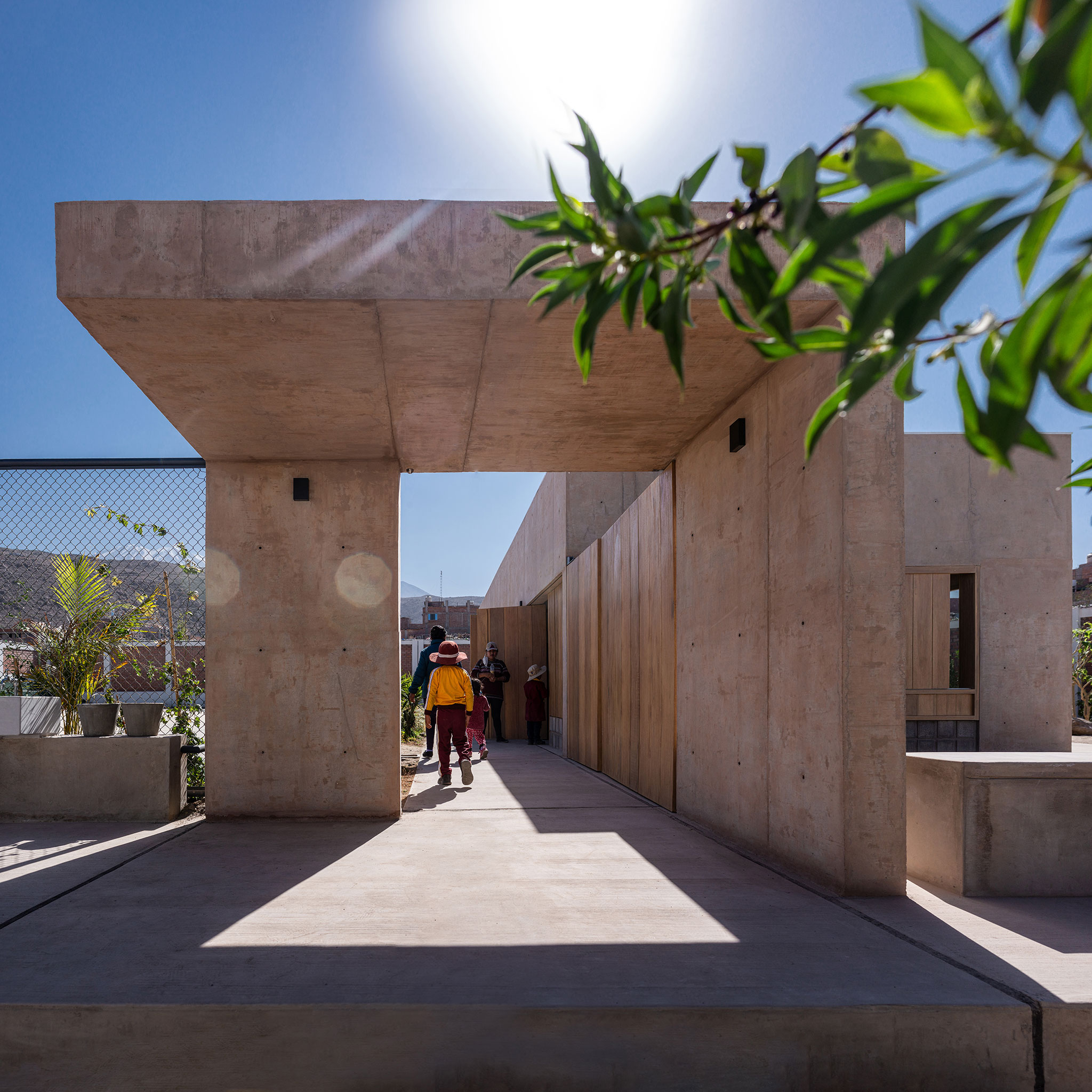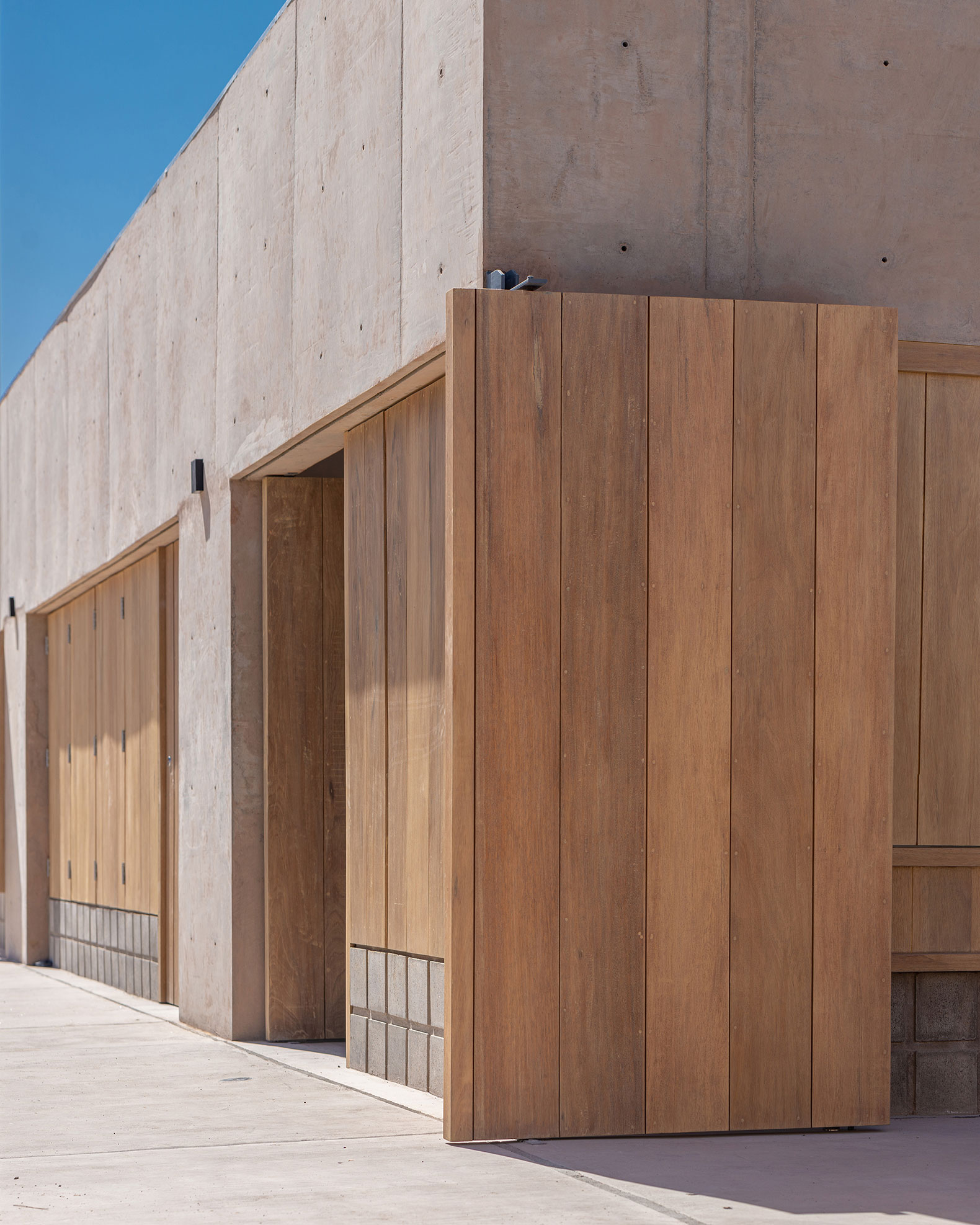Inside, the project presents spacious healthy spaces with good natural lighting, cross ventilation, and air regeneration through the upper skylights, avoiding any need for mechanical ventilation. The design has paid special attention to the identification of the concrete with the place through a simple technique so that the new classrooms are integrated by mimicry and have that reddish hue that gives Cerro Colorado its name.
The materials used in construction are linked to their environment, which has a common denominator among all constructions, which is the use of materials without any type of coating. A condition that the design assumed in the project, and promoting the use of materials as they are; exposed brick, exposed concrete, wood, calamine, and metal.

Children's school in Cerro Colorado by Betsaida Curto Reyes, Ander Bados Sesma. Photograph by Eleazar Cuadros, Mikel Beaumont
 Children's school in Cerro Colorado by Betsaida Curto Reyes, Ander Bados Sesma. Photograph by Eleazar Cuadros, Mikel Beaumont
Children's school in Cerro Colorado by Betsaida Curto Reyes, Ander Bados Sesma. Photograph by Eleazar Cuadros, Mikel Beaumont
Description of project by Betsaida Curto Reyes, Ander Bados Sesma
After the floods suffered by Arequipa in 2013, the NGO All Hands and Hearts rebuilt the Villa Magisterial School, in the community of Cerro Colorado, in the northern cono of the city and at the foot of the Misti and Chachani volcanoes. “Conos” in Peru are human settlements, erected on the outskirts of cities, and established by migrants from the jungle and highlands. These neglected areas have limited urban planning.
It has taken three and a half years to observe and understand the area; the environment, the traditions, and the construction systems. Through multiple participatory meetings with the school personnel and local neighbourhood, we have come together to recognize their needs.
Varying cultures influence the identity of this specific cono. One could define the urban fabric of the community as organised anarchy, fashioned with different construction techniques, depending on the geographic origin of the builder: bamboo roofs, concrete floors, brick or wooden walls. Such diverse raw materials and influences have established an unusual and extraordinary personality of this place, where contrasting self-building styles converge.
As the project originated from the community itself, they chose to incorporate and recognize their surroundings, and understand its value. The only common denominator among all the previous constructions is the use of materials with no type of coating. With this in mind, we consciously adopted it as our project concept.
We enhanced the materials in their most natural form; exposed brick, exposed concrete, wood, calamine, and metal. This equally meant meaningful cost savings without losing the essence of the materials and the architecture. The untainted material in its natural state allows the community to closer identify with the building and the way it is built, recognizing that an unplastered wall remains equally beautiful.
The struggle to give recognition to local constructions often considered on the fringes of architectural discipline and to break the establishment's approach of not considering these actions as works of architecture was essential to our process.
We chose building materials directly associated with its surroundings. We aimed to achieve our goals by following the formal model of the existing school, using large beams and columns, flat roofs, and exposed bricks.
Inside, we have devised spaces with clean lines, good natural lighting, cross-ventilation, and air regeneration through the upper skylights, avoiding any need for mechanical ventilation. We exaggerated the importance of the concrete through a simple technique so that the new classrooms embody the reddish hue that gives Cerro Colorado its name.
As a functional building, the faculty shared a passion for the school to have great flexibility in the face of changing student numbers. Additionally, they required space between the soccer field and the playground. It is now a transitional element between the old and new buildings, with graded terraces and an outdoor dining area. There is a multi-purpose classroom that can be divided into two smaller ones, employing wooden joinery.

Children's school in Cerro Colorado by Betsaida Curto Reyes, Ander Bados Sesma. Photograph by Eleazar Cuadros, Mikel Beaumont
For who?
Our designs acknowledged the school as a communal meeting place and a setting for the transmission of knowledge. For this reason, the building adapts to the diverse requirements present in the local area.
We designed the spaces as suitable for multiple purposes. We worked with specific solutions tailored to the children’s education as well as using the ‘urban scale’ to create exterior spaces that can be community-based.
We wanted to reaffirm the sense of identity that can be achieved through architecture; to reinforce the pride of this unique community and hopefully in the memories of children, transmit to future generations.
Why?
Due to an increasing birth rate, the number of students rose considerably in the last five years and there was no longer enough space in the existing school buildings. Prefabricated classrooms had been used to meet the original requirements of the school. After several conversations with the local population, the people of Cerro Colorado requested the construction of two classrooms and a kitchen, different from the pre-existing buildings which were also prefabricated and without running water.
From the beginning, our aim was for the community to feel a sense of ownership of the school. As the children spend many hours of the day between the classrooms and the kitchen, it was fundamental to provide areas of playfulness, dignity, and quality. We aspired to design a common and neutral space, unassuming in its natural environment, where daily inequalities are not so latent and the pride of the community flourishes.
The challenge was to achieve the same standard of facilities as the fee-paying schools but with reduced costs. Our final design reflects our understanding that excellence in architecture does not relate to wealth or territory. We intended that this school is a milestone within the region, our philosophy being; a work of architecture without branding or surnames (social, development cooperation), acknowledging architecture for what it is... design, community, collectiveness.


































































